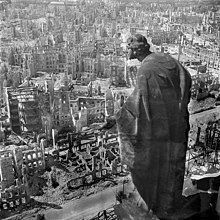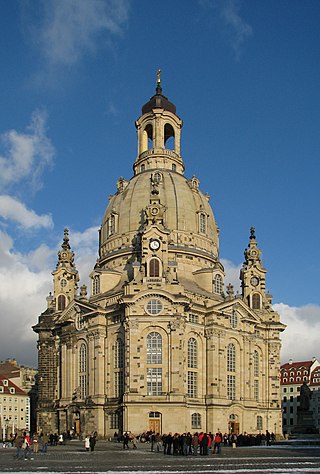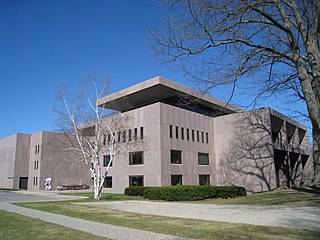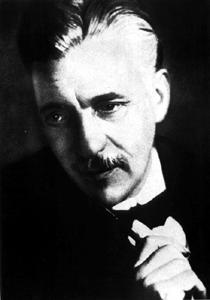This article needs additional citations for verification .(December 2009) |
| |||
|---|---|---|---|
| Buildings and structures +... |
The year 1945 in architecture involved some significant events.
This article needs additional citations for verification .(December 2009) |
| |||
|---|---|---|---|
| Buildings and structures +... |
The year 1945 in architecture involved some significant events.



Walter Adolph Georg Gropius was a German-American architect and founder of the Bauhaus School, who, along with Alvar Aalto, Ludwig Mies van der Rohe, Le Corbusier and Frank Lloyd Wright, is widely regarded as one of the pioneering masters of modernist architecture. He was a founder of Bauhaus in Weimar (1919). Gropius was also a leading architect of the International Style.

Dresden is the capital city of the German state of Saxony and its second most populous city after Leipzig. It is the 12th most populous city of Germany, the fourth largest by area, and the third most populous city in the area of former East Germany, after Berlin and Leipzig. Dresden's urban area comprises the towns of Freital, Pirna, Radebeul, Meissen, Coswig, Radeberg and Heidenau and has around 790,000 inhabitants. The Dresden metropolitan area has approximately 1.34 million inhabitants.

The Dresden Frauenkirche is a Lutheran church in Dresden, the capital of the German state of Saxony. Destroyed during the Allied firebombing of Dresden towards the end of World War II, the church was reconstructed between 1994 and 2005.

Augustus III was King of Poland and Grand Duke of Lithuania from 1733 until 1763, as well as Elector of Saxony in the Holy Roman Empire where he was known as Frederick Augustus II.

Benjamin C. Thompson was an American architect. He was one of eight architects who founded The Architects Collaborative (TAC) in 1945 in Cambridge, Massachusetts, one of the most notable firms in post-war modernism, and then started his own firm, Benjamin Thompson and Associates (BTA), in 1967.
The year 2001 in architecture involved some significant architectural events and new buildings.

The Architects Collaborative (TAC) was an American architectural firm formed by eight architects that operated between 1945 and 1995 in Cambridge, Massachusetts. The founding members were Norman C. Fletcher (1917–2007), Jean B. Fletcher (1915–1965), John C. Harkness (1916–2016), Sarah P. Harkness (1914–2013), Robert S. McMillan (1916–2001), Louis A. McMillen (1916–1998), Benjamin C. Thompson (1918–2002), and Walter Gropius (1883–1969). TAC created many successful projects, and was well respected for its broad range of designs, being considered one of the most notable firms in post-war modernism.
Jean Bodman Fletcher was an American architect who was a founding member of the well-respected design firm known as TAC, the Architects' Collaborative in Cambridge, Massachusetts.

John Cheesman "Chip" Harkness was an American architect who was a founder and partner of The Architects Collaborative (TAC) in Cambridge, Massachusetts with Walter Gropius and six other architects. He was a part of TAC from its inception in 1945 until the firm's demise in 1995.
The year 1808 in architecture involved some significant events.

Six Moon Hill is a residential neighborhood and historic district of mid-century modern houses in Lexington, Massachusetts.

Marian Marianovich Peretyatkovich was a Russian and Polish architect. His premature death at the age of 43 limited his career to only eight years of independent practice (1908-1916), however, he managed to excel in a rational (Finnish) variety of late Art Nouveau, Renaissance Revival and Russian Revival in Saint Petersburg and Moscow. He is sometimes compared with Louis Sullivan on account of his insistence on functionality of office buildings.

Renaissance Revival architecture is a group of 19th-century architectural revival styles which were neither Greek Revival nor Gothic Revival but which instead drew inspiration from a wide range of classicizing Italian modes. Under the broad designation Renaissance architecture 19th-century architects and critics went beyond the architectural style which began in Florence and Central Italy in the early 15th century as an expression of Renaissance humanism; they also included styles that can be identified as Mannerist or Baroque. Self-applied style designations were rife in the mid- and later 19th century: "Neo-Renaissance" might be applied by contemporaries to structures that others called "Italianate", or when many French Baroque features are present.
The year 1916 in architecture involved some significant events.

Ilya Alexandrovich Golosov was an architect from the late Russian Empire and early Soviet Union. A leader of Constructivism in 1925-1931, Ilya Golosov later developed his own style of early stalinist architecture known as postconstructivism. Не was a brother of Panteleimon Golosov.

Postconstructivism was a transitional architectural style that existed in the Soviet Union in the 1930s, typical of early Stalinist architecture before World War II. The term postconstructivism was coined by Selim Khan-Magomedov, a historian of architecture, to describe the product of avant-garde artists' migration to Stalinist neoclassicism. Khan-Magomedov identified postconstructivism with 1932–1936, but the long construction time and vast size of the country extended the period to 1941.

Reconstruction in architectural conservation is the returning of a place to a known earlier state by the introduction of new materials. It is related to the architectural concepts of restoration and preservation, wherein the most extensive form of reconstruction is creating a replica of a destroyed building.
The year 2012 in architecture involved some significant architectural events and new buildings.
The year 2021 in architecture involved some significant architectural events and new buildings.